Preserving the Authenticity of ST25 Rice (Oryza sativa) from the Mekong Delta: A Multivariate Geographical Characterization Approach
Abstract
:1. Introduction
2. Results and Discussion
2.1. Organoleptic Characteristics of ST25 Rice Samples
2.2. Infrared Spectroscopy Analysis
2.3. Elemental Measurement Using ICP-MS
2.4. Geographical Classification Using Principle Component Analysis
2.4.1. Geographical Classification Based on FTIR Dataset
2.4.2. Geographical Classification Based on ICP-MS Dataset
3. Materials and Methods
3.1. Sample Collection and Preparation
3.2. Chemicals and Reagents
3.3. FTIR Analysis
3.4. Elemental Quantification
3.5. Data Treatment and Statistical Analysis
4. Conclusions
Author Contributions
Funding
Data Availability Statement
Acknowledgments
Conflicts of Interest
References
- Kathiresan, A.; Nagai, T.; Haneishi, Y. Policy Options for Galvanizing Africa’s Rice Sector against Impacts of COVID-19. World Dev. 2020, 136, 105126. [Google Scholar] [CrossRef] [PubMed]
- Vietnams Rice Exports: The Worlds Second Largest Exporter Still Unstable. Available online: https://www.2lua.vn/article/vietnam-s-rice-exports-the-world-s-second-largest-exporter-still-unstable-60e282789eda11c44f6a56f9.html (accessed on 9 August 2022).
- Tu, V.H.; Kopp, S.W.; Trang, N.T.; Kontoleon, A.; Yabe, M. UK Consumers’ Preferences for Ethical Attributes of Floating Rice: Implications for Environmentally Friendly Agriculture in Vietnam. Sustainability 2021, 13, 8354. [Google Scholar] [CrossRef]
- ST25 Rice of Vietnam Wins Award at World’s Best Rice Contest 2020. Available online: https://english.vov.vn/en/economy/st25-rice-of-vietnam-wins-award-at-worlds-best-rice-contest-2020-822207.vov (accessed on 10 August 2022).
- Renewing ST25 Rice Brand to Combat Counterfeits. Available online: https://vietnamagriculture.nongnghiep.vn/renewing-st25-rice-brand-to-combat-counterfeits-d302642.html (accessed on 10 August 2022).
- Vietnam Protects Its ST25 Rice Brand in Australia. Available online: https://hanoitimes.vn/vietnam-protects-its-st25-rice-brand-in-australia-317201.html (accessed on 15 August 2022).
- Vietnam’s Battle to Market Its Prized Rice. Available online: https://thediplomat.com/2021/07/vietnams-battle-to-market-its-prized-rice/ (accessed on 10 August 2022).
- VietnamPlus. Vietnam’s ST25 Rice Enters Japanese Market. Available online: https://en.vietnamplus.vn/vietnams-st25-rice-enters-japanese-market/232027.vnp (accessed on 15 August 2022).
- Kaavya, R.; Pandiselvam, R.; Mohammed, M.; Dakshayani, R.; Kothakota, A.; Ramesh, S.V.; Cozzolino, D.; Ashokkumar, C. Application of Infrared Spectroscopy Techniques for the Assessment of Quality and Safety in Spices: A Review. Appl. Spectrosc. Rev. 2020, 55, 593–611. [Google Scholar] [CrossRef]
- Counterfeit and Imitation ST25 Rice. Bestsellers. Available online: https://nongnghiep.vn/gao-st25-gia-nhai-ban-chay-d293867.html (accessed on 10 August 2022). (In Vietnamese).
- Danezis, G.P.; Tsagkaris, A.S.; Brusic, V.; Georgiou, C.A. Food Authentication: State of the Art and Prospects. Curr. Opin. Food Sci. 2016, 10, 22–31. [Google Scholar] [CrossRef]
- Rohman, A.; Man, Y.B.C. The Chemometrics Approach Applied to FTIR Spectral Data for the Analysis of Rice Bran Oil in Extra Virgin Olive Oil. Chemometr. Intell. Lab. Syst. 2012, 110, 129–134. [Google Scholar] [CrossRef]
- Nguyen-Quang, T.; Do-Hoang, G.; Truong-Ngoc, M. Multielement Analysis of Pakchoi (Brassica Rapa L. ssp. Chinensis) by ICP-MS and Their Classification According to Different Small Geographical Origins. J. Anal. Methods Chem. 2021, 2021, 8860852. [Google Scholar] [CrossRef] [PubMed]
- Selih, V.S.; Sala, M.; Drgan, V. Multi-Element Analysis of Wines by ICP-MS and ICP-OES and Their Classification according to Geographical Origin in Slovenia. Food Chem. 2014, 153, 414–423. [Google Scholar] [CrossRef] [PubMed]
- Geana, I.; Iordache, A.; Ionete, R.; Marinescu, A.; Ranca, A.; Culea, M. Geographical Origin Identification of Romanian Wines by ICP-MS Elemental Analysis. Food Chem. 2013, 138, 1125–1134. [Google Scholar] [CrossRef] [PubMed]
- Kruzlicova, D.; Fiket, Ž.; Kniewald, G. Classification of Croatian Wine Varieties Using Multivariate Analysis of Data Obtained by High Resolution ICP-MS Analysis. Food Res. Int. 2013, 54, 621–626. [Google Scholar] [CrossRef]
- Bong, Y.-S.; Song, B.-Y.; Gautam, M.K.; Jang, C.-S.; An, H.J.; Lee, K.-S. Discrimination of the Geographic Origin of Cabbages. Food Control 2013, 30, 626–630. [Google Scholar] [CrossRef]
- Vietnamese Rice, the ‘World’s Best’–What Makes It Special, and Where to Buy? Available online: https://nld.com.vn/kinh-te/gao-viet-ngon-nhat-the-gioi-co-gi-dac-biet-20191113115411304.htm (accessed on 10 August 2022). (In Vietnamese).
- From Humble Start to World’s Best Rice. Available online: https://vir.com.vn/from-humble-start-to-worlds-best-rice-84154.html (accessed on 10 August 2022).
- Christou, C.; Agapiou, A.; Kokkinofta, R. Use of FTIR Spectroscopy and Chemometrics for the Classification of Carobs Origin. J. Adv. Res. 2018, 10, 1–8. [Google Scholar] [CrossRef] [PubMed]
- Giang, L.T.; Thien, T.L.T.; Yen, D.H. Rapid Classification of Rice in Northern Vietnam by Using FTIR Spectroscopy Combined with Chemometrics Methods: Rapid Classification of Rice in Northern Vietnam by Using FTIR Spectroscopy Combined with Chemometrics Methods. Vietnam J. Chem. 2020, 58, 372–379. [Google Scholar] [CrossRef]
- IR Spectrum Table & Chart. Available online: https://www.sigmaaldrich.com/VN/en/technical-documents/technical-article/analytical-chemistry/photometry-and-reflectometry/ir-spectrum-table (accessed on 12 August 2022).
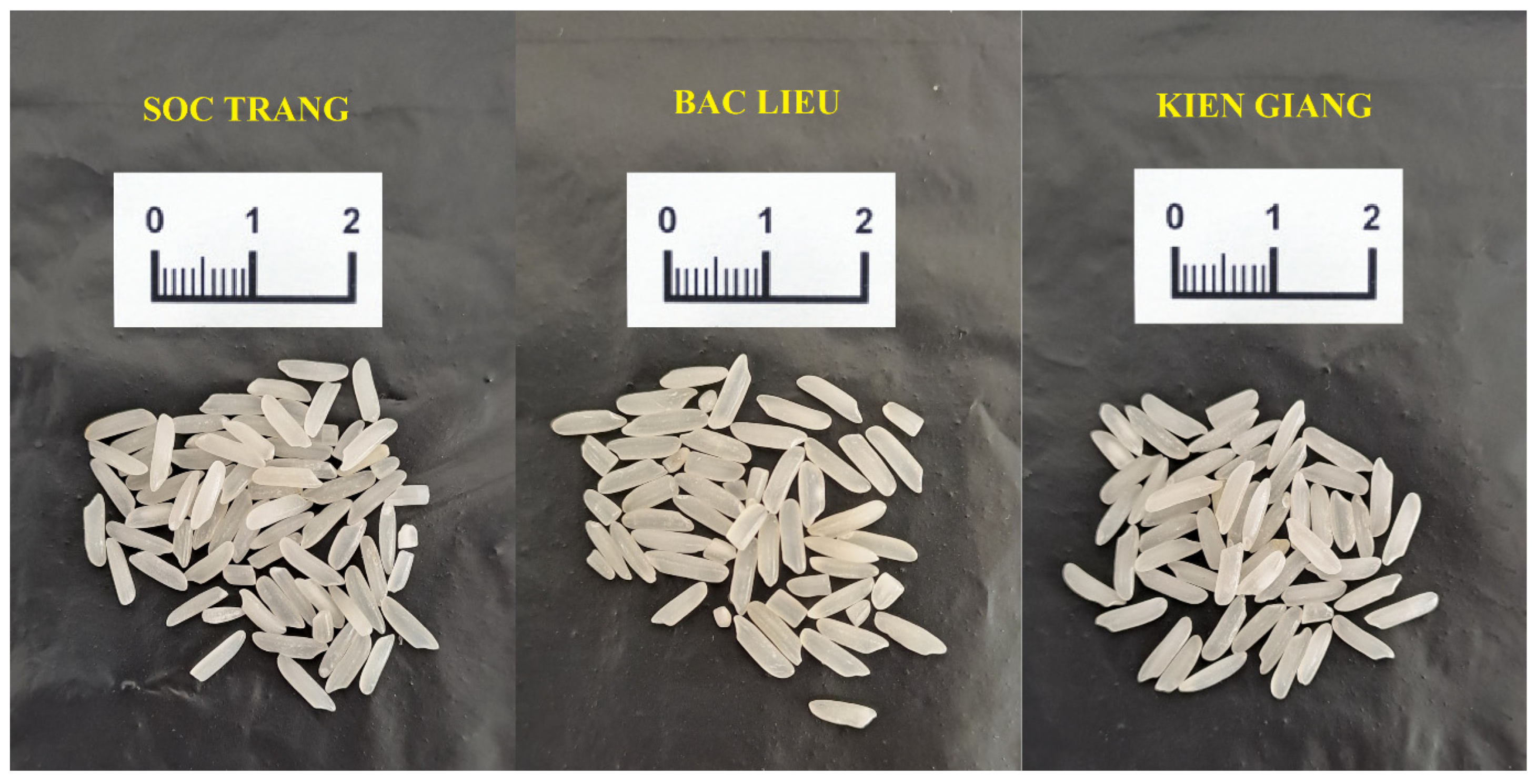

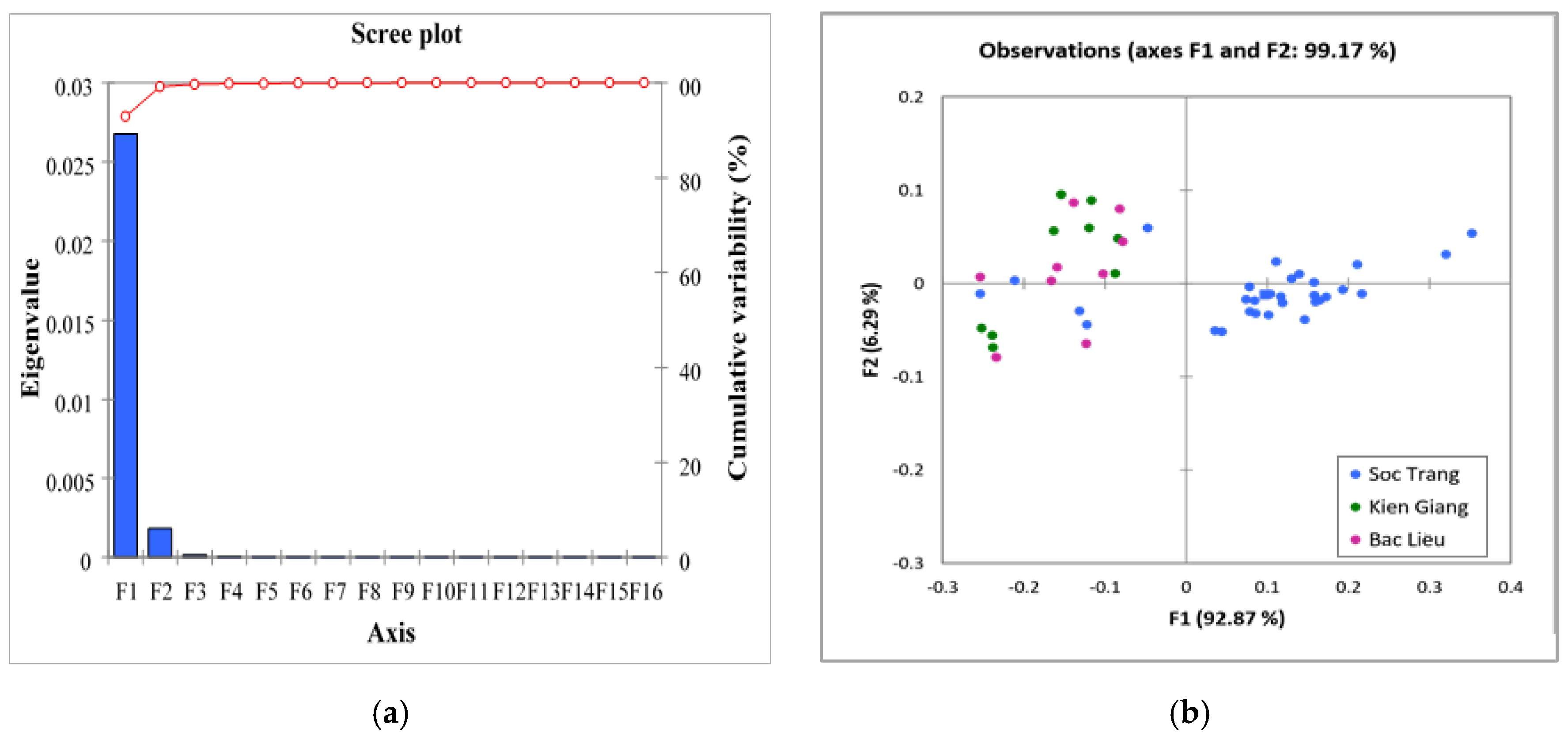
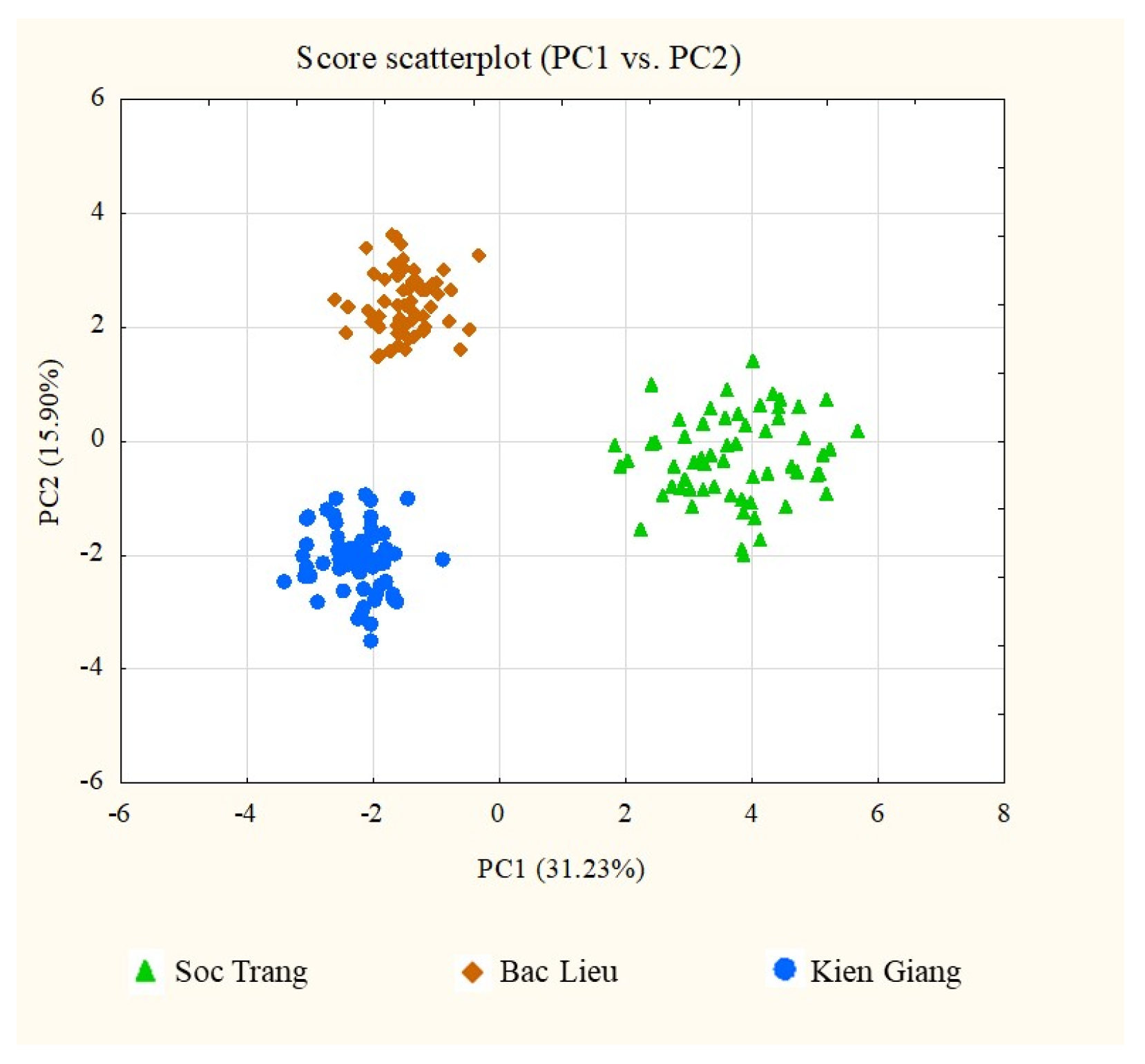
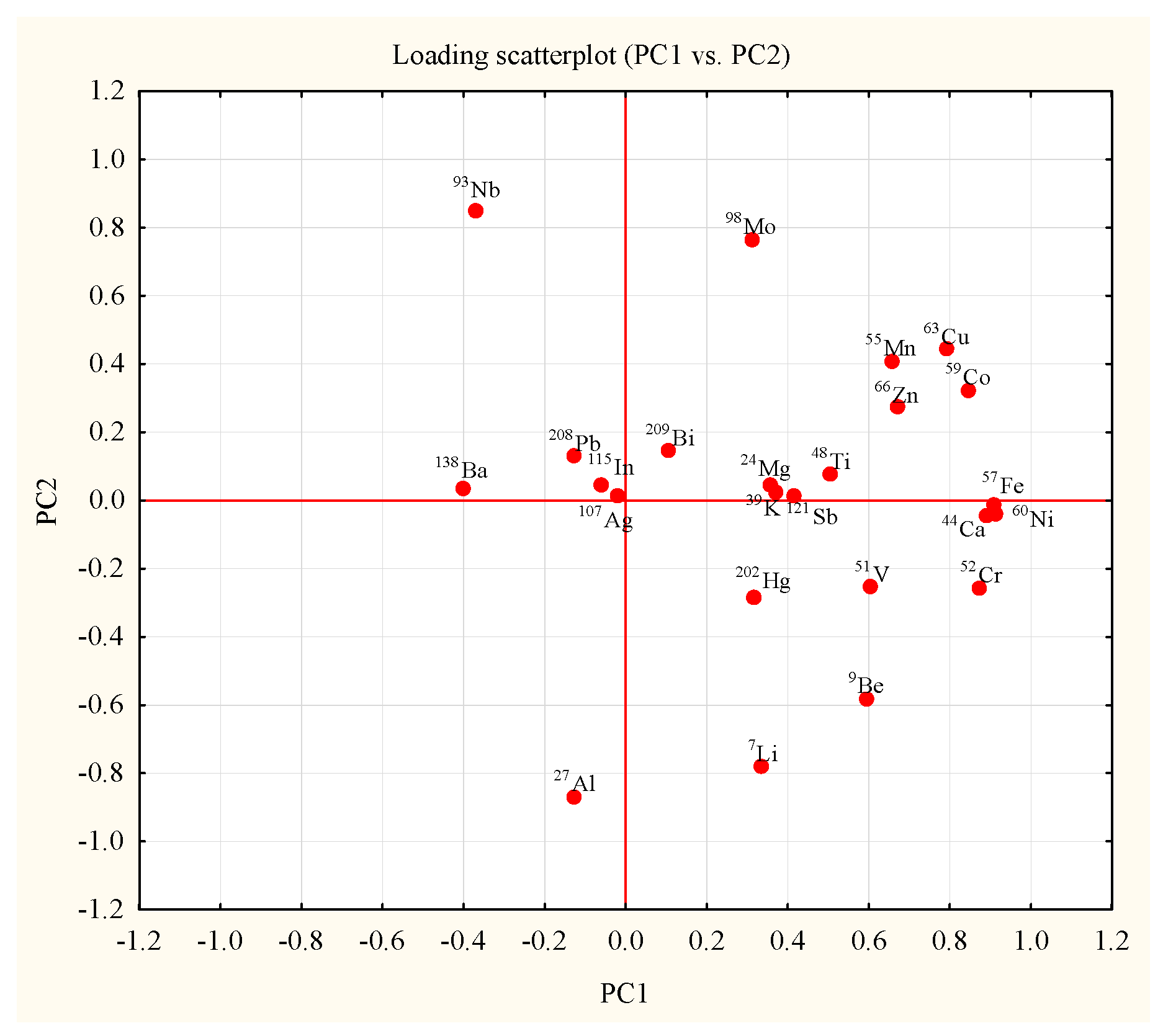


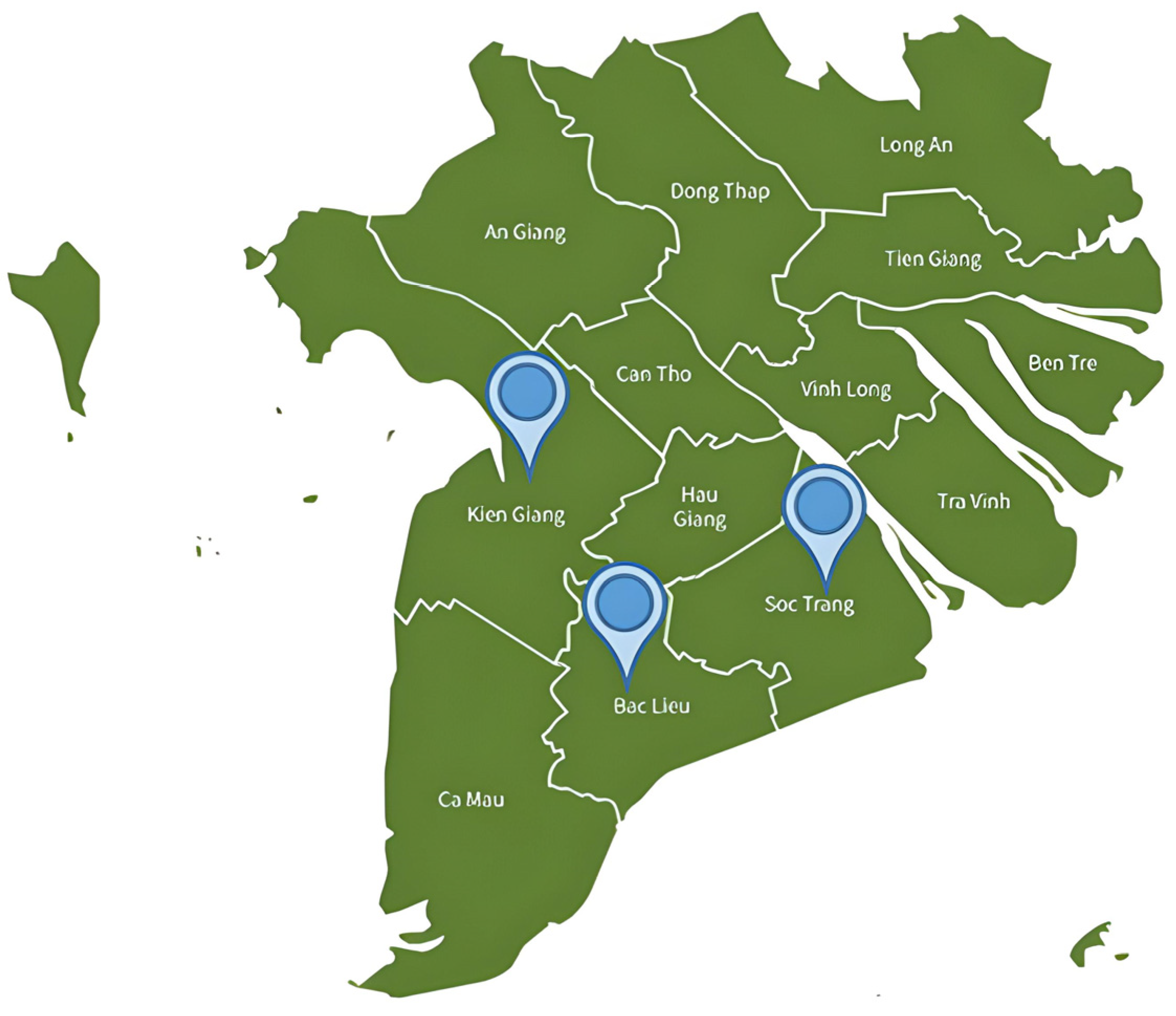
| Wavelength Region (cm−1) | Selected Peaks | Vibration of Functional Groups | Primary Compound Class | References |
|---|---|---|---|---|
| 3600–3000 | 3294 | O–H and N–H groups (Stretching vibration) | Polysaccharides, amine, alcohol | [21,22] |
| 3000–2500 | 2928 | C–H stretching | Alkyne, alkene, alkane | [21,22] |
| 1670–1600 | 1638 | C=O and C=C stretching | Alkene | [21,22] |
| 1600–1300 | 1540 | N-O stretching | Nitro compound | [21] |
| 1413 | Rocking vibrations of CH bond | Cis-disubstituted alkenes | [21] | |
| 1337 | CH3 bending vibrations | Lipids, proteins | [21,22] | |
| 1300–1000 | 1236 | C–N stretching | Amine | [22] |
| 1148 | C–O stretching | Alcohol, ester | [22] | |
| 1077 | C–O stretching | Alcohol | [22] | |
| 1000–400 | 995–413 | “Fingerprint region” | - | [22] |
| Element | Geographical Regions (mg/g DW) | ||
|---|---|---|---|
| Soc Trang | Kien Giang | Bac Lieu | |
| 7Li | 0.14 ± 0.01 | 0.13 ± 0.01 | 0.06 ± 0.002 |
| 23Na | 8.82 ± 0.33 | 6.78 ± 0.40 | 3.47 ± 0.15 |
| 24Mg | 16.62 ± 0.91 | 13.67 ± 0.71 | 15.11 ± 0.92 |
| 27Al | 1.10 ± 0.04 | 1.60 ± 0.07 | 0.57 ± 0.01 |
| 39K | 63.14 ± 3.18 | 53.72 ± 2.25 | 54.96 ± 3.45 |
| 44Ca | 45.07 ± 2.51 | 14.51 ± 0.58 | 16.81 ± 0.79 |
| 48Ti | 0.24 ± 0.02 | 0.19 ± 0.01 | 0.20 ± 0.01 |
| 51V | 0.05 ± 0.002 | 0.04 ± 0.001 | 0.03 ± 0.001 |
| 52Cr | 4.42 ± 0.33 | 1.59 ± 0.07 | 1.13 ± 0.05 |
| 55Mn | 1.67 ± 0.07 | 0.79 ± 0.05 | 1.34 ± 0.08 |
| 57Fe | 25.1 ± 1.32 | 7.43 ± 0.56 | 9.57 ± 0.46 |
| 59Co | 0.04 ± 0.002 | - | 0.02 ± 0.001 |
| 60Ni | 2.71 ± 0.12 | 0.57 ± 0.04 | 0.80 ± 0.06 |
| 63Cu | 0.31 ± 0.02 | 0.06 ± 0.003 | 0.21 ± 0.01 |
| 66Zn | 6.66 ± 0.35 | 3.70 ± 0.22 | 5.05 ± 0.24 |
| 93Nb | - | - | 0.06 ± 0.003 |
| 98Mo | 0.07 ± 0.003 | 0.04 ± 0.002 | 0.08 ± 0.003 |
| 111Cd | 0.03 ± 0.001 | 0.03 ± 0.001 | 0.03 ± 0.001 |
| 115In | 0.03 ± 0.002 | 0.03 ± 0.002 | 0.03 ± 0.002 |
| 121Sb | 0.01 ± 0.00 | 0.01 ± 0.00 | 0.01 ± 0.00 |
| 138Ba | 0.65 ± 0.02 | 0.82 ± 0.03 | 0.76 ± 0.03 |
| 202Hg | 0.03 ± 0.001 | 0.02 ± 0.001 | 0.02 ± 0.001 |
| 208Pb | 0.11 ± 0.004 | 0.11 ± 0.01 | 0.12 ± 0.01 |
| 209Bi | 0.09 ± 0.01 | 0.09 ± 0.004 | 0.09 ± 0.004 |
Disclaimer/Publisher’s Note: The statements, opinions and data contained in all publications are solely those of the individual author(s) and contributor(s) and not of MDPI and/or the editor(s). MDPI and/or the editor(s) disclaim responsibility for any injury to people or property resulting from any ideas, methods, instructions or products referred to in the content. |
© 2023 by the authors. Licensee MDPI, Basel, Switzerland. This article is an open access article distributed under the terms and conditions of the Creative Commons Attribution (CC BY) license (https://creativecommons.org/licenses/by/4.0/).
Share and Cite
Bui, D.T.; Truong, N.M.; Le, V.A.; Nguyen, H.K.; Bui, Q.M.; Pham, V.T.; Nguyen, Q.T. Preserving the Authenticity of ST25 Rice (Oryza sativa) from the Mekong Delta: A Multivariate Geographical Characterization Approach. Stresses 2023, 3, 653-664. https://doi.org/10.3390/stresses3030045
Bui DT, Truong NM, Le VA, Nguyen HK, Bui QM, Pham VT, Nguyen QT. Preserving the Authenticity of ST25 Rice (Oryza sativa) from the Mekong Delta: A Multivariate Geographical Characterization Approach. Stresses. 2023; 3(3):653-664. https://doi.org/10.3390/stresses3030045
Chicago/Turabian StyleBui, Dinh Tri, Ngoc Minh Truong, Viet Anh Le, Hoang Khanh Nguyen, Quang Minh Bui, Van Thinh Pham, and Quang Trung Nguyen. 2023. "Preserving the Authenticity of ST25 Rice (Oryza sativa) from the Mekong Delta: A Multivariate Geographical Characterization Approach" Stresses 3, no. 3: 653-664. https://doi.org/10.3390/stresses3030045
APA StyleBui, D. T., Truong, N. M., Le, V. A., Nguyen, H. K., Bui, Q. M., Pham, V. T., & Nguyen, Q. T. (2023). Preserving the Authenticity of ST25 Rice (Oryza sativa) from the Mekong Delta: A Multivariate Geographical Characterization Approach. Stresses, 3(3), 653-664. https://doi.org/10.3390/stresses3030045









